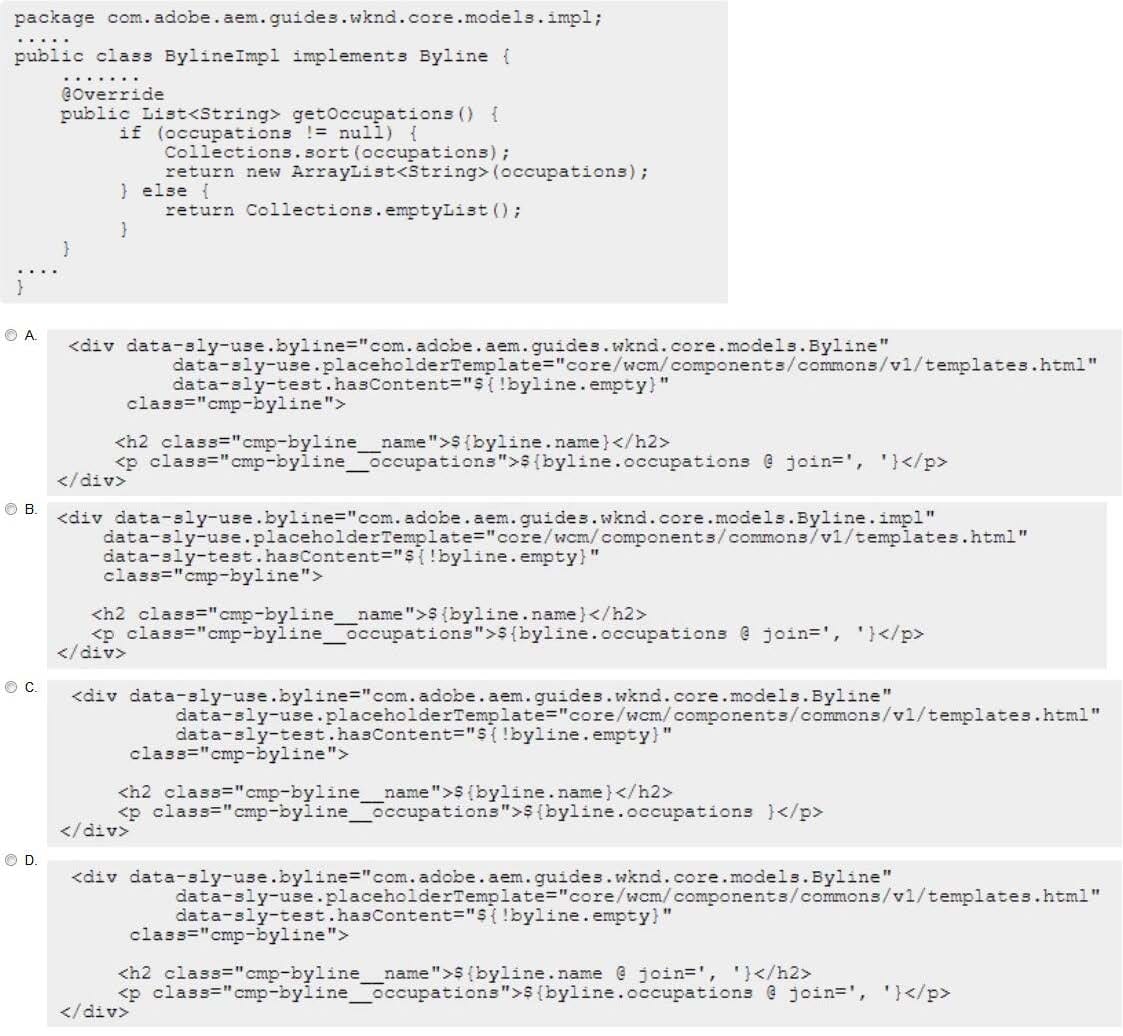Exam Details
Exam Code
:AD0-E134Exam Name
:Adobe Experience Manager Developer ExamCertification
:Adobe CertificationsVendor
:AdobeTotal Questions
:72 Q&AsLast Updated
:Aug 24, 2025
Adobe Adobe Certifications AD0-E134 Questions & Answers
-
Question 11:
An AEM application has a Header and Footer authored on every page.
The customer asks for the following:
1.
A centralized Header and Footer
2.
The ability to create a variation for both the Header and Footer
3.
Change the Header and Footer for specific time periods
4.
The ability to restore a previous version for both the Header and Footer
What should the developer use to meet the requirements?
A. Custom component
B. Content fragment
C. Static template
D. Experience fragment
-
Question 12:
An AEM Developer needs to create a new component to help support a new product launch.
The client is on AEM 6.5 on-premise with the latest version of WCM Core Components The component must include text, image, and a link The component must support multiple designs
Which process should the AEM Developer use to support the launch?
A. 1. Extend the Teaser Component from Core Components
2. Create style variations to be used in the Style System
B. 1. Create a new component by extending the Text Component from Core Components
2. Add dialog properties and modify HTL to support images
C. 1. Extend the Text Component from Core Components
2. Enable image manipulations for the Text Component via policy
D. 1. Create a new Image with Text component that exposes the Core Components authoring dialogs for those components
2. Add a policy to define which designs are used
-
Question 13:
What is the recommended path to override /libs standard functionality?
A. /conf
B. /apps
C. /content
D. /Iibs
-
Question 14:
A developer needs to create sling models for two fields name and occupations. The dialog has two fields, name - a single value field, and occupations - a multi value field. The following code is included in sling models inherited from interface com.adobe.aem.guides.wknd.core.models.Byline

A. Option A
B. Option B
C. Option C
D. Option D
-
Question 15:
A developer has to create a Logger and Writer pair for the company's application logging. Which OSGi configurations should the developer use?
A. Apache Sling Logging Logger Configuration and Apache Sling Logging Configuration
B. Apache Sling Request Logger and Apache Sling Logging Writer Configuration
C. Apache Sling Logging Logger Configuration and Apache Sling Logging Writer Configuration
-
Question 16:
An AEM development team is working on a new multi-country application using AEM as a Cloud Service. A developer has been assigned the task for building the integration with a third-party web service. A secret key is needed to connect
with this web service. The website creators will provide this key. The key is different for each type of environment (dev, stage and production)
What is the recommended way to make the secret key available in the AEM application?
A. Use a context aware configuration
B. Read the key value from a property file stored in the code base
C. Use an environment variable which is then consumed by an OSGi configuration
D. Read the key value from OSGi configuration stored in run nNdes
-
Question 17:
An application development team needs to create a multi-channel application that uses AEM as a headless CMS. Which feature should be used to maintain structured data for this application?
A. Static template
B. Content fragment
C. Experience fragment
D. Custom component
-
Question 18:
An AEM application is expected to export a content fragment in JSON format without any customization for a headless implementation.
What is the recommended approach?
A. Use AEM Assets HTTP API
B. Use Core components to export JSON
C. Use Sling Exporter framework
-
Question 19:
Which configuration must be applied to enable re-fetching of cached items based on Cache Headers sent by AEM?
A. /autolnvalidate true
B. /autolnvalidate "1"
C. /enableTTLtrue
D. /enableTTL "1"
-
Question 20:
What two types of testing are available OOB in AEM Cloud Manager Pipeline? (Select Two.)
A. Code Quality testing
B. Performance testing
C. Ul testing
D. Penetration testing
E. Integration testing
Related Exams:
9A0-019
Adobe Photoshop 6.0 Product Proficiency9A0-042
Acrobat 7.0 Prowith Adobe LiveCycle Designer ACE Exam9A0-043
Adobe Illustrator CS 2 ACE9A0-044
Adobe Photoshop CS 2 ACE Exam9A0-045
Adobe InDesign CS 2 ACE Exam9A0-046
Adobe GoLive CS2 ACE Exam9A0-055
Adobe InDesign CS3 ACE Exam9A0-056
Adobe Dreamweaver CS3 ACE Exam9A0-057
Adobe Illustrator CS3 ACE Exam9A0-058
Adobe Flash CS3 ACE Exam
Tips on How to Prepare for the Exams
Nowadays, the certification exams become more and more important and required by more and more enterprises when applying for a job. But how to prepare for the exam effectively? How to prepare for the exam in a short time with less efforts? How to get a ideal result and how to find the most reliable resources? Here on Vcedump.com, you will find all the answers. Vcedump.com provide not only Adobe exam questions, answers and explanations but also complete assistance on your exam preparation and certification application. If you are confused on your AD0-E134 exam preparations and Adobe certification application, do not hesitate to visit our Vcedump.com to find your solutions here.